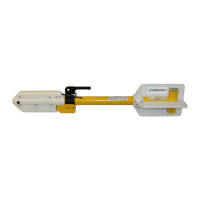Geometrics Inc. G-882 Cesium Marine Magnetometer Page 26
logging software or terminal software may be used to communicate with the
G−882. Refer to the front of this manual for the Quick-start G−882 Harware
and Software Operating Instructions to help with the initial setup and running
of the magnetometer.
We receive many common questions about how to operate the G−882
magnetometer and we offer a few of them here for your review:
A. What is a good boat speed? Is there a maximum or minimum?
Most surveys are conducted at between 4 and 6 knots. The speed of the
vessel will control the depth of the sensor fish because the drag of the cable
dominates. Therefore higher speeds mean a more shallow tow. The tow
cable is rated for 700 lbs continuous working load. Short tow cables (less
than 500 ft) can be towed at up to 10 knots.
B. I want to tow 200 ft deep, what are my options?
In general, we suggest that you use our online depth calculator offered on our
website at http://www.geometrics.com/TowDepth.htm . Users can substitute
G−881 for the G−882 in the program. (See Figure 30 below).
A quick calculation will show you that getting your sensor to 100 feet depth
(30m) is not too difficult but to get beyond that depth, it will require
significantly more cable, slowing down the survey and adding weight collars
to the fish. Each weight collar is 14lbs. To get to 100 ft (30m) depth will
require 500 ft of Kevlar cable, towing at 3 knots with 1 extra 14lb collar
weight. Moving to 4 knots will raise the fish to a depth of 75 feet (25m)!

